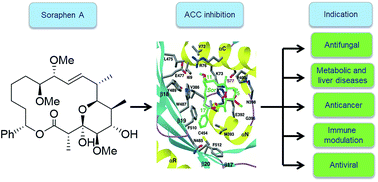The intriguing chemistry and biology of soraphens
Abstract
Covering: up to the end of 2018
Soraphens are a class of polyketide natural products discovered from the myxobacterial strain Sorangium cellulosum. The review is intended to provide an overview on the biosynthesis, chemistry and biological properties of soraphens, that represent a prime example to showcase the value of natural products as tools to decipher cell biology, but also to open novel therapeutic options. The prototype soraphen A is an inhibitor of acetyl coenzyme A carboxylase (ACC1/2), an enzyme that converts acetyl-CoA to malonyl-CoA and thereby controls essential cellular metabolic processes like lipogenesis and fatty acid oxidation. Soraphens illustrate how the inhibition of a single target (ACC1/2) may be explored to treat various pathological conditions: initially developed as a fungicide, efforts in the past decade were directed towards human diseases, including diabetes/obesity, cancer, hepatitis C, HIV, and autoimmune disease – and led to a synthetic molecule, discovered by virtual screening of the allosteric binding site of soraphen in ACC, that is currently in phase 2 clinical trials. We will summarize how structural analogs of soraphen A have been generated through extensive isolation efforts, genetic engineering of the biosynthetic gene cluster, semisynthesis as well as partial and total synthesis.



 Please wait while we load your content...
Please wait while we load your content...